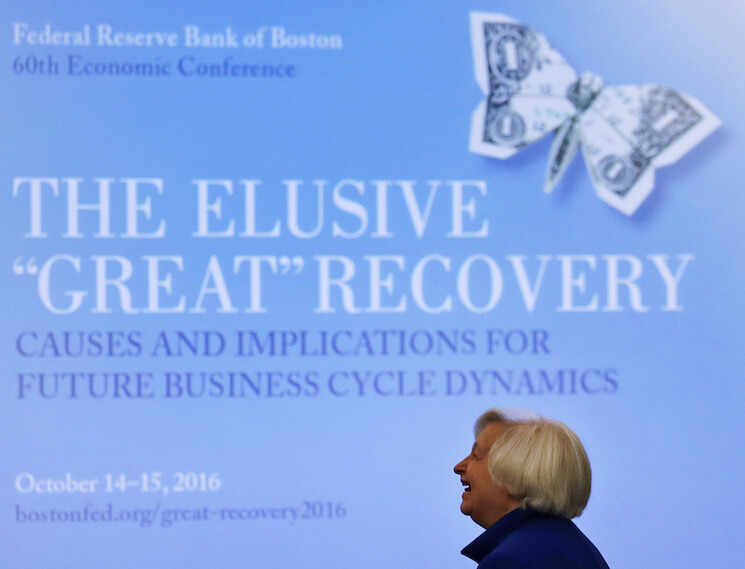Yellen poses important post-Great Recession macroeconomic questions

Last week at a Federal Reserve Bank of Boston conference, Federal Reserve Chair Janet Yellen gave a speech on macroeconomics research in the wake of the Great Recession. She identifies several key areas for macroeconomics research in the future, particularly in areas that will be informative for U.S. policymakers. Yellen lists four areas for research, but let’s look more closely at the first two groups of questions that she elevates.
The first is the influence of aggregate demand on aggregate supply. As Yellen notes, the traditional way of thinking about this relationship would be that demand, a short-run phenomenon, has no significant effect of aggregate supply, which determines long-run economic growth. The potential growth rate of an economy is determined by aggregate supply and the fluctuations around that long-term trend—recessions and expansions, according to this line of thinking. Basically, the ups and downs of the business cycle are determined by changes in aggregate demand. Yet the slow growth of the past several years has many economists rethinking this relationship.
Yellen points to research that increasingly finds so called hysteresis effects in the macroeconomy. Hysteresis, a term borrowed from physics, is the idea that short-run shocks to the economy can alter its long-term trend. One example of hysteresis is workers who lose jobs in recessions and then aren’t drawn back into the labor market bur rather are permanently locked out, therefore increasing the long-run unemployment rate. Interesting new research argues that hysteresis may affect not just the labor supply but also the rate of productivity growth.
If hysteresis is prevalent in the economy, then U.S. policymakers need to rethink their fiscal and monetary policy priorities. The effects of hysteresis may mean that economic recoveries need to run longer and hotter than previous thought in order to get workers back into the labor market or allow other resources to get back into full use.
The other set of open research questions that Yellen raises is the influence of “heterogeneity” on aggregate demand. In many models of the macroeconomy, households are characterized by a representative agent, meaning that all households are assumed to be the same on average and therefore don’t consider differences in households and how they might react differently to different shocks. In short, they are assumed to be homogeneous. As Yellen notes in her speech, overall home equity remained positive after the bursting of the housing bubble, so a representative agent would have maintained positive equity in their home.
Yet a wealth of research in the wake of the Great Recession finds that millions of households whose mortgages were “underwater” and didn’t have positive wealth—a big reason for the severity of the downturn. Ignoring this heterogeneity in the housing market and its effects on economic inequality seems like something modern macroeconomics needs to resolve. Economists are increasingly moving in this direction, but even more movement would very helpful.
Yellen raises other areas of inquiry in her speech, including better understanding how the financial system is linked to the real economy and how the dynamics of inflation are determined. Perhaps it’s time for each of these questions to rise on the collective research list so that policymakers have better vantage points as they assess the effect of inequality on economic growth and stability. As Paul Krugman has noted several times over the past several years, the Great Recession doesn’t seem to have provoked the same rethink of macroeconomics compared to the Great Depression, which ushered in Keynesianism, and the stagflation of the 1970s, which led to the ascendance of new classical economics. The U.S. economy is similarly dealing with a “new normal.” Macroeconomics needs to respond this reality.
